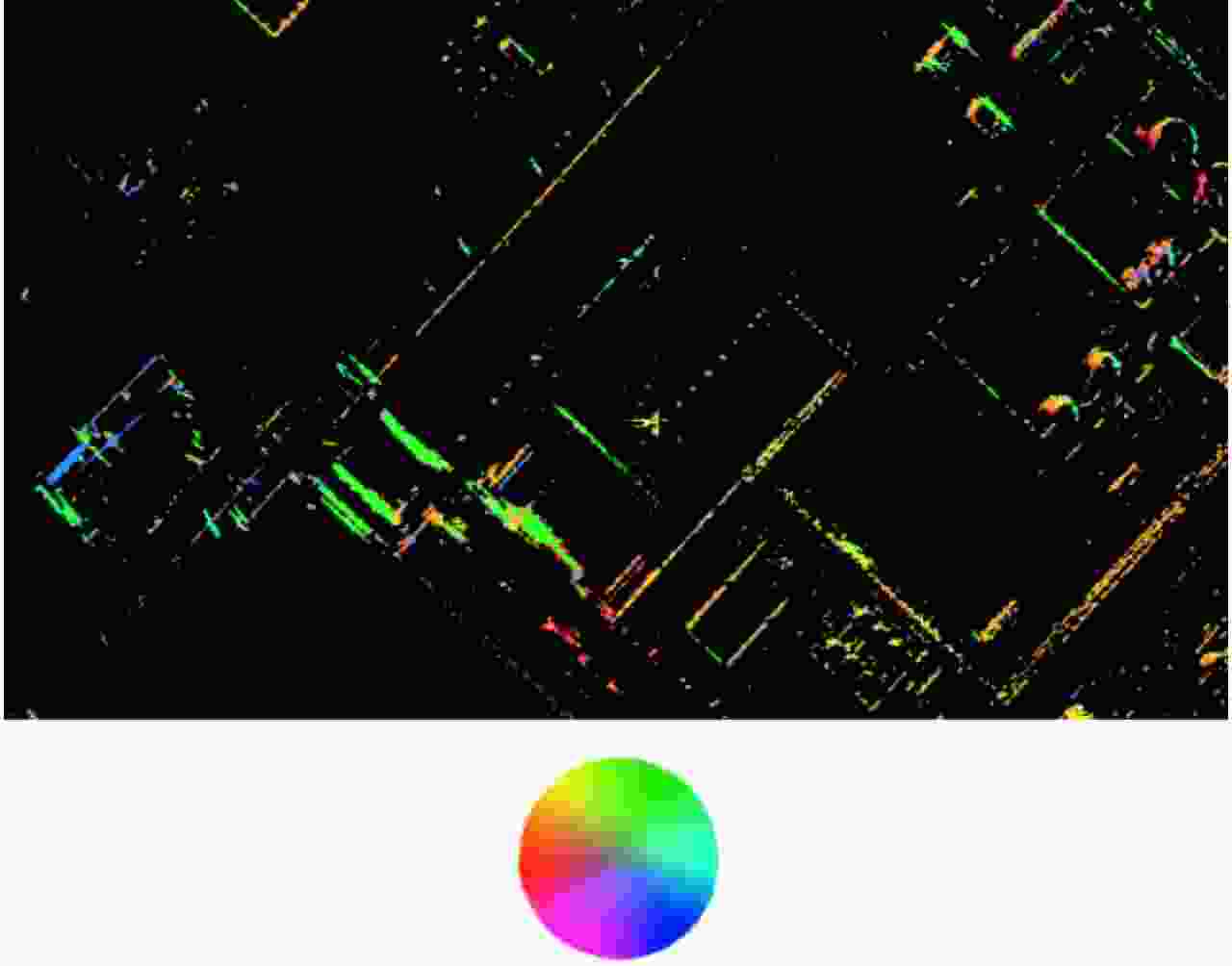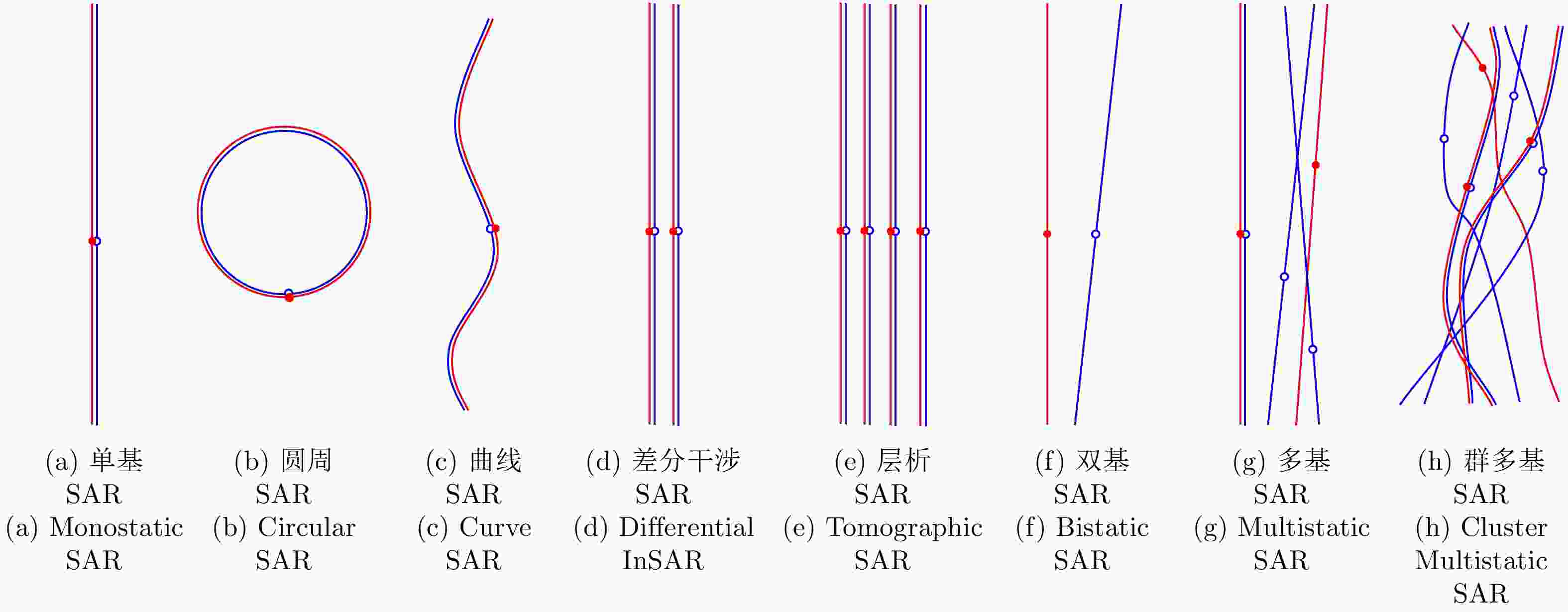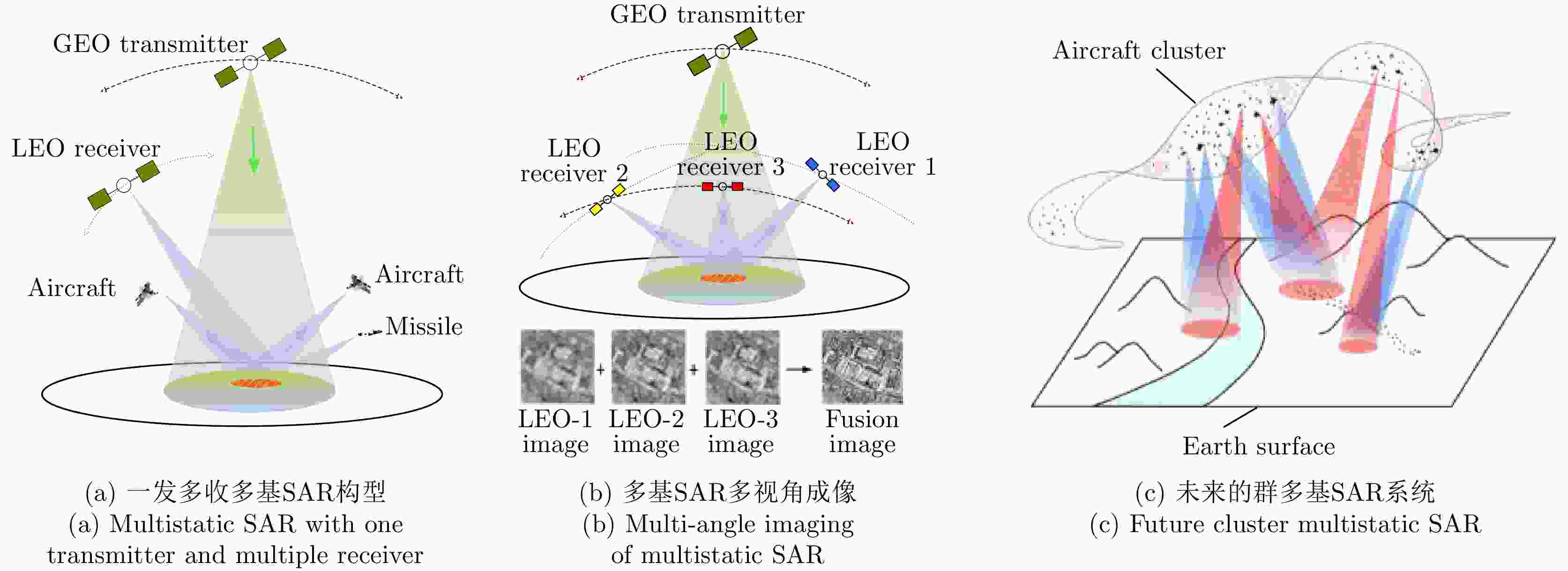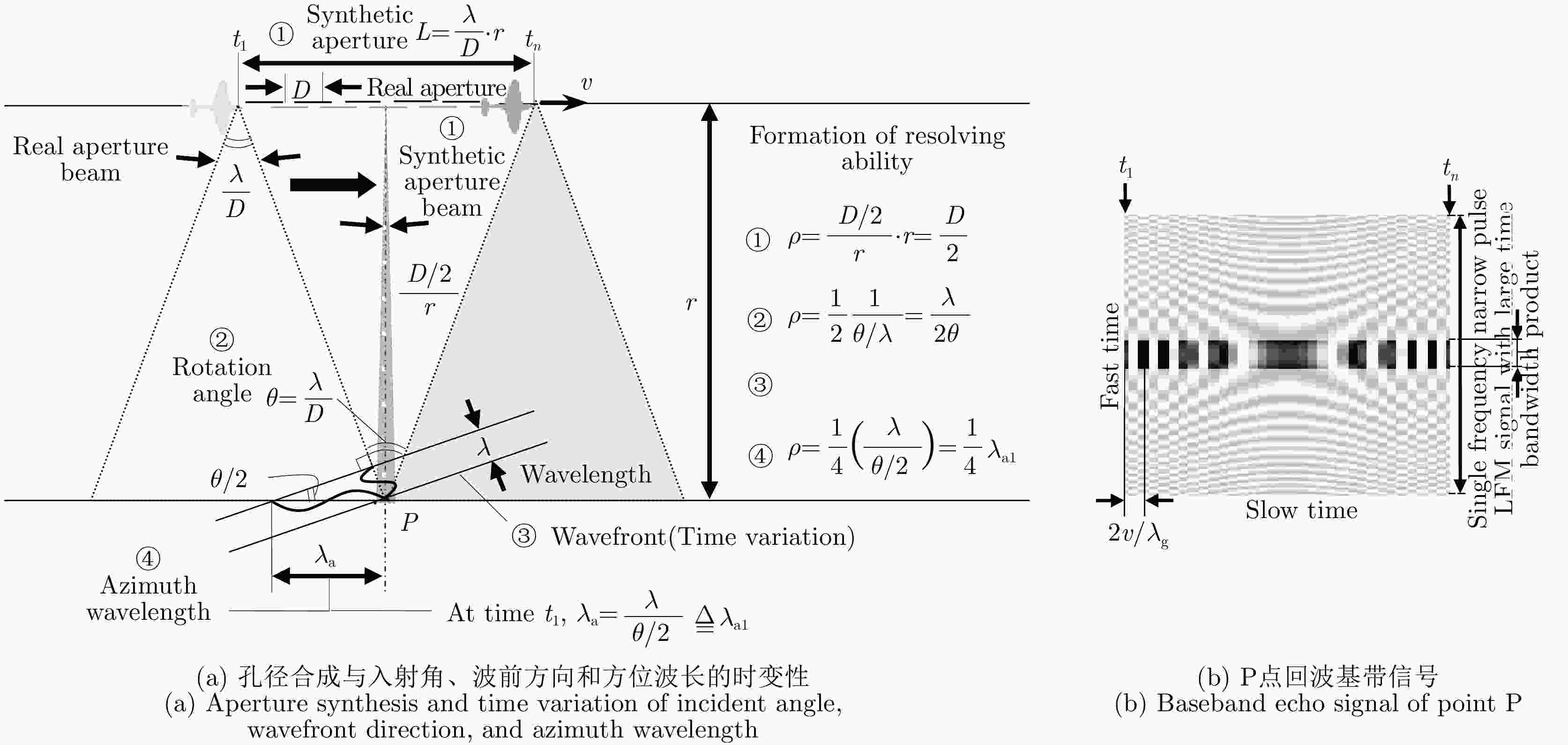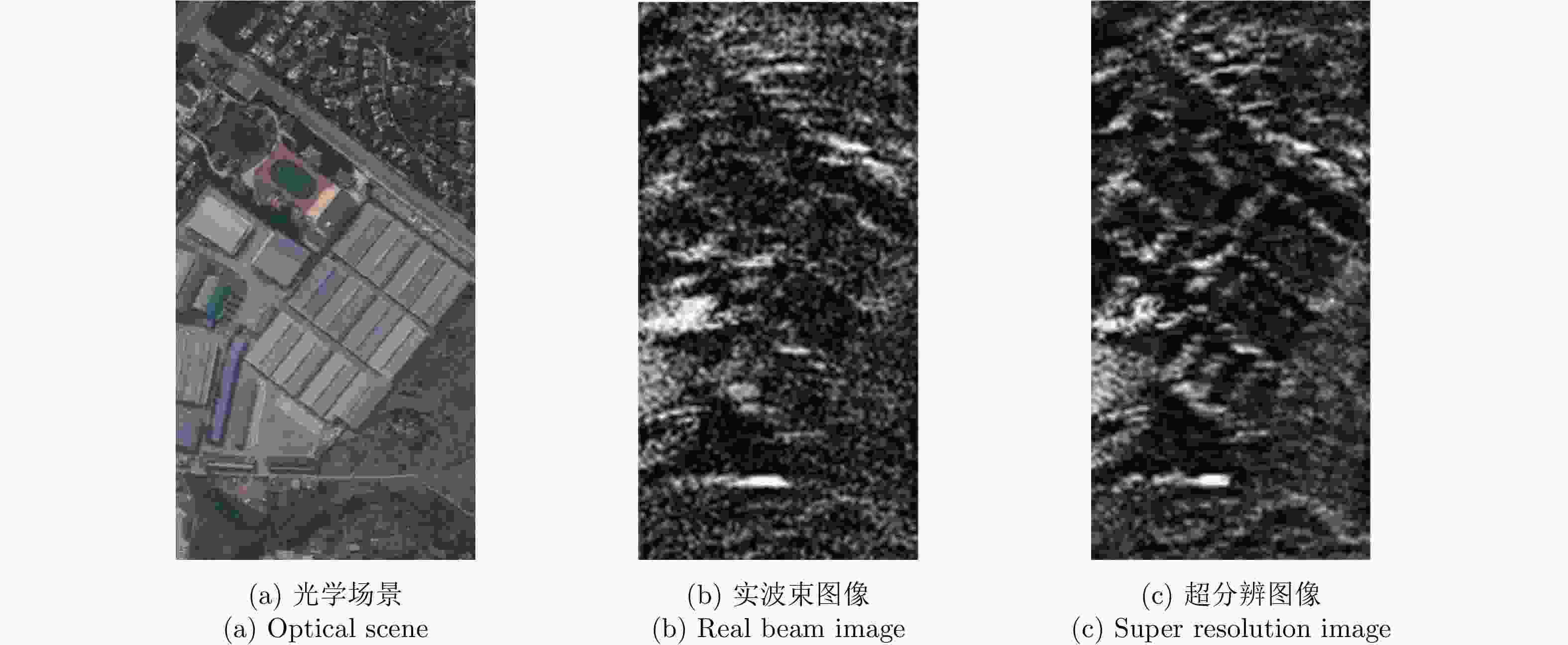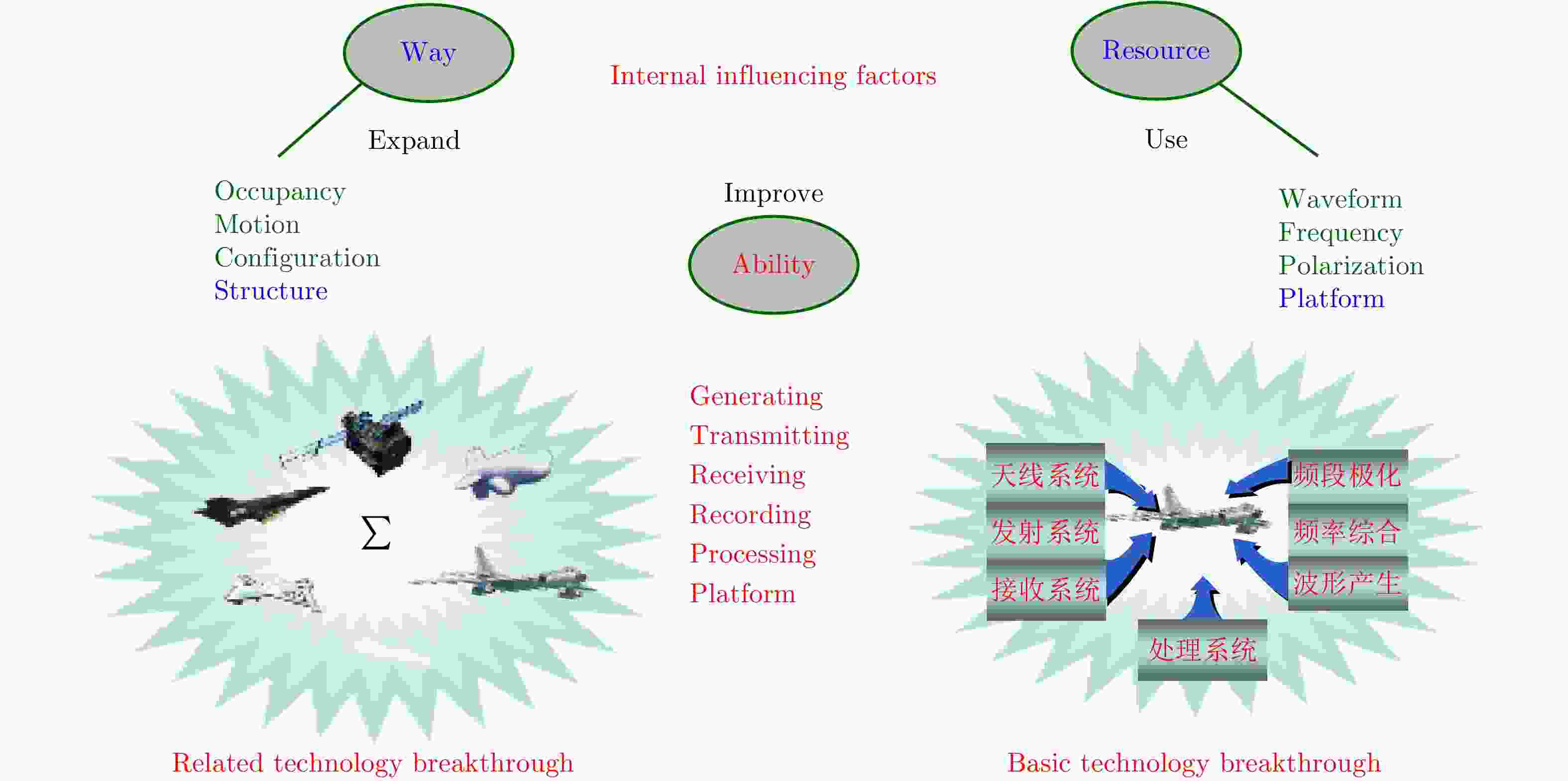Multi-directional Evolution Trend and Law Analysis of Radar Ground Imaging Technology(in English)
-
摘要:
该文从成像结果表征、孔径流形、信号通道、系统形态、观测方向、处理方法、实现机理、目标识别等方面剖析了雷达对地成像技术的多向演化态势,并试图从宏观的视角和大的时间尺度,分析和认识雷达对地成像技术发展的内外因素和发展规律,推演预测未来发展方向,以期为把握雷达对地成像技术发展的时代脉络和宏观趋势、契合需求和引领创新、推动发展和促进应用,提供另类的观察视角和思维方式。
Abstract:This paper analyzes the multi-directional evolution of radar ground imaging technology from the aspects of the representation of imaging results, aperture manifolds, signal channels, system morphologies, observation directions, processing methods, realization mechanisms, and target recognition. Attempts are made to analyze and understand the internal and external factors as well as the development law of radar ground imaging technology from a macroscopic perspective over a long time scale, and to predict the direction of future development. Alternative observation perspective and thinking method are proposed with a view to advance the understanding of the times veins and macro trends of radar ground imaging technology, meet practical needs, lead innovation efforts, and promote development and applications.
-
Key words:
- Radar imaging /
- Macro trend /
- Influencing factors /
- Development law
-
图 5 极化干涉SAR原理与地物三维成像结果[17]
Figure 5. Principle of Pol-InSAR and three-dimensional imaging result
图 8 孔径流形的演变②
Figure 8. Evolution of the aperture manifold
图 15 建筑群的三维成像[25]
Figure 15. Three-dimensional imaging of buildings
图 16 多通道SAR演进图③
Figure 16. Multi-channel SAR evolution map
图 26 合成孔径原理的4种不同解释⑤
Figure 26. Four different interpretations of synthetic aperture principle
-
[1] 吴一戎, 朱敏慧. 合成孔径雷达技术的发展现状与趋势[J]. 遥感技术与应用, 2000, 15(2): 121–123. doi: 10.3969/j.issn.1004-0323.2000.02.012WU Yirong and ZHU Minhui. The developing status and trends of synthetic aperture radar[J]. Remote Sensing Technology and Application, 2000, 15(2): 121–123. doi: 10.3969/j.issn.1004-0323.2000.02.012 [2] MOREIRA A, PRATS-IRAOLA P, YOUNIS M, KRIEGER G, HAJNSEK I, and PAPATHANASSIOU K P. A tutorial on synthetic aperture radar[J]. IEEE Geoscience and Remote Sensing Magazine, 2013, 1(1): 6–43. doi: 10.1109/MGRS.2013.2248301 [3] 魏钟铨. 合成孔径雷达卫星[M]. 北京: 科学出版社, 2001.WEI Zhongquan. Synthetic Aperture Radar Satellite[M]. Beijing: Science Press, 2001. [4] 杨建宇. 雷达技术发展规律和宏观趋势分析[J]. 雷达学报, 2012, 1(1): 19–27. doi: 10.3724/SP.J.1300.2012.20010YANG Jianyu. Development laws and macro trends analysis of radar technology[J]. Journal of Radars, 2012, 1(1): 19–27. doi: 10.3724/SP.J.1300.2012.20010 [5] TURKAR V, DEO R, RAO Y S, MOHAN S, and DAS A. Classification accuracy of multi-frequency and multi-polarization SAR images for various land covers[J]. IEEE Journal of Selected Topics in Applied Earth Observations and Remote Sensing, 2012, 5(3): 936–941. doi: 10.1109/JSTARS.2012.2192915 [6] JIN Yaqiu and XU Feng. Polarimetric Scattering and SAR Information Retrieval[M]. Singapore: John Wiley & Sons Singapore Pte. Ltd., 2013. [7] 董庆, 郭华东, 王长林. 多波段多极化合成孔径雷达的海洋学应用[J]. 地球科学进展, 2001, 16(1): 93–97. doi: 10.3321/j.issn:1001-8166.2001.01.017DONG Qing, GUO Huadong, and WANG Changlin. Oceanographic survey of multi-band and multi-polarization synthetic aperture radar[J]. Advance in Earth Sciences, 2001, 16(1): 93–97. doi: 10.3321/j.issn:1001-8166.2001.01.017 [8] 王雪松. 雷达极化技术研究现状与展望[J]. 雷达学报, 2016, 5(2): 119–131. doi: 10.12000/JR16039WANG Xuesong. Status and prospects of radar polarimetry techniques[J]. Journal of Radars, 2016, 5(2): 119–131. doi: 10.12000/JR16039 [9] SUN Jili, YU Weidong, and DENG Yunkai. The SAR payload design and performance for the GF-3 mission[J]. Sensors, 2017, 17(10): 2419. doi: 10.3390/s17102419 [10] 宋国栋, 李建新, 张金平, 高铁. 新型双极化波导缝隙天线研究[J]. 现代雷达, 2010, 32(12): 67–71. doi: 10.3969/j.issn.1004-7859.2010.12.015SONG Guodong, LI Jianxin, ZHANG Jinping, and GAO Tie. A study on the novel waveguide slotted antenna with dual-polarization[J]. Modern Radar, 2010, 32(12): 67–71. doi: 10.3969/j.issn.1004-7859.2010.12.015 [11] WANG Yu, YU Weidong, and WANG Chunle. A hierarchical extension of a multiple-component scattering model with unitary transformation of the coherency matrix[J]. Remote Sensing Letters, 2019, 10(11): 1047–1056. doi: 10.1080/2150704X.2019.1646933 [12] WANG Jili, YU Weidong, DENG Yunkai, WANG R, WANG Yingjie, ZHANG Heng, and ZHENG Mingjie. Demonstration of time-series InSAR processing in Beijing using a small stack of gaofen-3 differential interferograms[J]. Journal of Sensors, 2019, 2019: 4204580. [13] 王超, 张红, 刘智, 陈锁忠, 闾国年. 苏州地区地面沉降的星载合成孔径雷达差分干涉测量监测[J]. 自然科学进展, 2002, 12(6): 621–624. doi: 10.3321/j.issn:1002-008X.2002.06.012WANG Chao, ZHANG Hong, LIU Zhi, CHEN Suozhong, and LÜ Guonian. Differential interferometry and monitoring of ground subsidence by satellite-borne synthetic aperture radar in Suzhou[J]. Progress in Natural Science, 2002, 12(6): 621–624. doi: 10.3321/j.issn:1002-008X.2002.06.012 [14] TENG Fei, HONG Wen, LIN Yun, HAN Bing, WANG Yanping, SHEN Wenjie, and FENG Shanshan. An anisotropic scattering analysis method based on likelihood ratio using circular Sar Data[C]. 2019 IEEE International Geoscience and Remote Sensing Symposium, Yokohama, Janpan, 2019: 477–480. [15] FERRETTI A, MONTI-GUARNIERI A, PRATI C, ROCCA F, and MASSONET D InSAR principles: Guidelines for SAR interferometry processing and interpretation[R]. ESA TM-19, 2007. [16] JONES H G and VAUGHAN R A. Remote Sensing of Vegetation: Principles, Techniques, and Applications[M]. Oxford: Oxford University Press, 2010. [17] PAPATHANASSIOU K P and CLOUDE S R. Single-baseline polarimetric SAR interferometry[J]. IEEE Transactions on Geoscience and Remote Sensing, 2001, 39(11): 2352–2363. doi: 10.1109/36.964971 [18] DAMINI A, BALAJI B, PARRY C, and MANTLE V. A videoSAR mode for the x-band wideband experimental airborne radar[C]. The SPIE 7699, Algorithms for Synthetic Aperture Radar Imagery XVⅡ, Orlando, USA, 2010: 76990E. [19] Sandia National Laboratories: Infrared-VideoSAR comparison[EB/OL]. https://www.sandia.gov/radar/video/index.html, 2019. [20] 胡睿智. 视频合成孔径雷达成像理论与关键技术研究[D]. [博士论文], 电子科技大学, 2018.HU Ruizhi. Research on imaging theory and key technology of video synthetic aperture radar[D]. [Ph.D. dissertation], University of Electronic Science and Technology of China, 2018. [21] ROSA R A S, FERNANDES D, NOGUEIRA J B, and WIMMER C. Automatic change detection in multitemporal X- and P-band SAR images using Gram-Schmidt process[C]. 2015 IEEE International Geoscience and Remote Sensing Symposium, Milan, Italy, 2015: 2797–2800. [22] 杨建宇. 双基合成孔径雷达[M]. 北京: 国防工业出版社, 2017.YANG Jianyu. Bistatic Synthetic Aperture Radar[M]. Beijing: National Defense Industry Press, 2017. [23] 洪文. 圆迹SAR成像技术研究进展[J]. 雷达学报, 2012, 1(2): 124–135. doi: 10.3724/SP.J.1300.2012.20046HONG Wen. Progress in circular SAR imaging technique[J]. Journal of Radars, 2012, 1(2): 124–135. doi: 10.3724/SP.J.1300.2012.20046 [24] CHEN Leping, AN Daoxiang, and HUANG Xiaotao. A backprojection-based imaging for circular synthetic aperture radar[J]. IEEE Journal of Selected Topics in Applied Earth Observations and Remote Sensing, 2017, 10(8): 3547–3555. doi: 10.1109/JSTARS.2017.2683497 [25] 丁赤飚, 仇晓兰, 徐丰, 梁兴东, 焦泽坤, 张福博. 合成孔径雷达三维成像——从层析、阵列到微波视觉[J]. 雷达学报, 2019, 8(6): 693–709. doi: 10.12000/JR19090DING Chibiao, QIU Xiaolan, XU Feng, LIANG Xingdong, JIAO Zekun, and ZHANG Fubo. Synthetic aperture radar three-dimensional imaging——from TomoSAR and array InSAR to microwave vision[J]. Journal of Radars, 2019, 8(6): 693–709. doi: 10.12000/JR19090 [26] 孙龙, 邬伯才, 沈明星, 江凯, 鲁加国. 机载UWB数字阵列SAR系统技术研究[J]. 雷达科学与技术, 2017, 15(2): 171–177, 184. doi: 10.3969/j.issn.1672-2337.2017.02.011SUN Long, WU Bocai, SHEN Mingxing, JIANG Kai, and LU Jiaguo. Research on UWB airborne digital array SAR technology[J]. Radar Science and Technology, 2017, 15(2): 171–177, 184. doi: 10.3969/j.issn.1672-2337.2017.02.011 [27] 代大海, 邢世其, 王玺, 庞礡. 数字阵列合成孔径雷达[M]. 北京: 国防工业出版社, 2017.DAI Dahai, XING Shiqi, WANG Xi, and PANG Bo. Digital Array Synthetic Aperture Radar[M]. Beijing: National Defense Industry Press, 2017. [28] ZHANG Jiajia, SUN Guangcai, XING Mengdao, BAO Zheng, and FANG Zhou. An efficient signal reconstruction algorithm for stepped frequency MIMO-SAR in the spotlight and sliding spotlight modes[J]. International Journal of Antennas and Propagation, 2014, 2014: 329340. [29] 雷万明, 许道宝, 余慧, 刘颖. 距离向DBF-SAR自适应SCORE处理研究[J]. 现代雷达, 2019, 41(9): 37–40.LEI Wanming, XU Daobao, YU Hui, and LIU Ying. A study on adaptive SCORE processing for range DBF-SAR[J]. Modern Radar, 2019, 41(9): 37–40. [30] CERUTTI-MAORI D, KLARE J, BRENNER A R, and ENDER J H G. Wide-area traffic monitoring with the SAR/GMTI system PAMIR[J]. IEEE Transactions on Geoscience and Remote Sensing, 2008, 46(10): 3019–3030. doi: 10.1109/TGRS.2008.923026 [31] WEIß M, PETERS O, and ENDER J. First flight trials with ARTINO[C]. The 7th European Conference on Synthetic Aperture Radar, Friedrichshafen, Germany, 2008: 187–190. [32] 雷万明, 赵敬亮. 大带宽高分辨力多通道SAR频谱重构[J]. 宇航学报, 2011, 32(10): 2210–2215. doi: 10.3873/j.issn.1000-1328.2011.10.018LEI Wanming and ZHAO Jingliang. Doppler signal reconstruction of multichannel wide bandwidth SAR with high resolution[J]. Journal of Astronautics, 2011, 32(10): 2210–2215. doi: 10.3873/j.issn.1000-1328.2011.10.018 [33] WU Youming, YU Ze, XIAO Peng, and LI Chunsheng. Suppression of azimuth ambiguities in spaceborne SAR images using spectral selection and extrapolation[J]. IEEE Transactions on Geoscience and Remote Sensing, 2018, 56(10): 6134–6147. [34] 洪文, 王彦平, 林赟, 谭维贤, 吴一戎. 新体制SAR三维成像技术研究进展[J]. 雷达学报, 2018, 7(6): 633–654. doi: 10.12000/JR18109HONG Wen, WANG Yanping, LIN Yun, TAN Weixian, and WU Yirong. Research progress on three-dimensional SAR imaging technique[J]. Journal of Radars, 2018, 7(6): 633–654. doi: 10.12000/JR18109 [35] MAHAFZA B R and SAJJADI M. Three-dimensional SAR imaging using linear array in transverse motion[J]. IEEE Transactions on Aerospace and Electronic Systems, 1996, 32(1): 499–510. doi: 10.1109/7.481296 [36] WEIB M and ENDER J H G. A 3D imaging radar for small unmanned airplanes - ARTINO[C]. The European Radar Conference, Paris, Frend, 2005: 209–212. [37] SHI Jun, PENG Zuoyong, REN Congyue, FAN Ling, and ZHANG Xiaoling. DEM estimation for LASAR based on variational model[J]. IEEE Transactions on Geoscience and Remote Sensing, 2017, 55(2): 978–995. doi: 10.1109/TGRS.2016.2617402 [38] SHI Jun, ZHANG Xiaoling, YANG Jianyu, et al. APC trajectory design for “One-Active” linear-array three-dimensional imaging SAR[J]. IEEE Transactions on Geoscience and Remote Sensing, 2010, 48(3): 1470–1486. doi: 10.1109/TGRS.2009.2031430 [39] SHI Jun, ZHANG Xiaoling, YANG Jianyu, and WANG Yinbo. Surface-tracing-based LASAR 3-D imaging method via Multiresolution approximation[J].IEEE Transactions on Geoscience and Remote Sensing, 2008, 46(11): 3719–3730. doi: 10.1109/TGRS.2008.2001170 [40] ZHANG Siqian, DONG Ganggang, and KUANG Gangyao. Matrix completion for downward-looking 3-D SAR imaging with a random sparse linear array[J]. IEEE Transactions on Geoscience and Remote Sensing, 2018, 56(4): 1994–2006. doi: 10.1109/TGRS.2017.2771826 [41] ZHANG Siqian, ZHU Yutao, DONG Ganggang, and KUANG Gangyao. Truncated SVD-based compressive sensing for downward-looking three-dimensional SAR imaging with uniform/nonuniform linear array[J]. IEEE Geoscience and Remote Sensing Letters, 2015, 12(9): 1853–1857. doi: 10.1109/LGRS.2015.2431254 [42] ZHANG Siqian, DONG Ganggang, and KUANG Gangyao. Superresolution downward-looking linear array three-dimensional SAR imaging based on two-dimensional compressive sensing[J]. IEEE Journal of Selected Topics in Applied Earth Observations and Remote Sensing, 2016, 9(6): 2184–2196. doi: 10.1109/JSTARS.2016.2549548 [43] LI Hang, LIANG Xingdong, ZHANG Fubo, DING Chibiao, and Wu Yirong. A novel 3-D reconstruction approach based on group sparsity of array InSAR[J]. Scientia Sinica Informationis, 2018, 48(8): 1051–1064. doi: 10.1360/N112017-00023 [44] 李杭, 梁兴东, 张福博, 吴一戎. 基于高斯混合聚类的阵列干涉SAR三维成像[J]. 雷达学报, 2017, 6(6): 630–639. doi: 10.12000/JR17020LI Hang, LIANG Xingdong, ZHANG Fubo, and WU Yirong. 3D imaging for array InSAR based on Gaussian mixture model clustering[J]. Journal of Radars, 2017, 6(6): 630–639. doi: 10.12000/JR17020 [45] LOPEZ-DEKKER P, MALLORQUI J J, SERRA-MORALES P, and SANZ-MARCOS J. Phase synchronization and doppler centroid estimation in fixed receiver Bistatic SAR systems[J]. IEEE Transactions on Geoscience and Remote Sensing, 2008, 46(11): 3459–3471. doi: 10.1109/TGRS.2008.923322 [46] HE Zhihua, HE Feng, CHEN Junli, HUANG Haifeng, and LIANG Diannong. Phase synchronization processing method for alternating bistatic mode in distributed SAR[J]. Journal of Systems Engineering and Electronics, 2013, 24(3): 410–416. doi: 10.1109/JSEE.2013.00049 [47] YOCKY D A, WAHL D E, and JAKOWATZ C V. Bistatic SAR: Imagery & image products[R]. SAND2014-18346, 2014. [48] YATES G, HOME A M, BLAKE A P, and MIDDLETON R. Bistatic SAR image formation[J]. IEE Proceedings - Radar,Sonar and Navigation, 2006, 153(3): 208–213. doi: 10.1049/ip-rsn:20045091 [49] WALTERSCHEID I, ENDER J H G, BRENNER A R, and LOFFELD O. Bistatic SAR processing and experiments[J]. IEEE Transactions on Geoscience and Remote Sensing, 2006, 44(10): 2710–2717. doi: 10.1109/TGRS.2006.881848 [50] RODRIGUEZ-CASSOLA M, BAUMGARTNER S V, KRIEGER G, and MOREIRA A. Bistatic TerraSAR-X/F-SAR spaceborne-airborne SAR experiment: Description, data processing, and results[J]. IEEE Transactions on Geoscience and Remote Sensing, 2010, 48(2): 781–794. doi: 10.1109/TGRS.2009.2029984 [51] XIAN Li, XIONG Jintao, HUANG Yulin, and YANG Jianyu. Research on airborne bistatic SAR squint imaging mode algorithm and experiment data processing[C]. The 2007 1st Asian and Pacific Conference on Synthetic Aperture Radar, Huangshan, China, 2007: 618–621. [52] ULANDER L M H, FRÖLIND P O, GUSTAVSSON A, RAGNARSSON R, and STENSTRÖM G. VHF/UHF bistatic and passive SAR ground imaging[C]. Proceedings of 2015 IEEE Radar Conference, Arlington, USA, 2015: 669–673. [53] WU Junjie, SUN Zhichao, LI Zhongyu, HUANG Yulin, YANG Jianyu, and LIU Zhe. Focusing translational variant Bistatic forward-looking SAR using keystone transform and extended nonlinear chirp scaling[J]. Remote Sensing, 2016, 8(10): 840. doi: 10.3390/rs8100840 [54] PU Wei, WU Junjie, HUANG Yulin, LI Wenchao, SUN Zhichao, YANG Jianyu, and YANG Haiguang. Motion Errors and compensation for bistatic forward-looking SAR with cubic-order processing[J]. IEEE Transactions on Geoscience and Remote Sensing, 2016, 54(12): 6940–6957. doi: 10.1109/TGRS.2016.2592536 [55] WALTERSCHEID I and PAPKE B. Bistatic forward-looking SAR imaging of a runway using a compact receiver on board an ultralight aircraft[C]. The 2013 14th International Radar Symposium, Dresden, Germany, 2013: 461–466. [56] HU Cheng, ZENG Tao, LONG Teng, and YANG Chun. Forward-looking bistatic SAR range migration alogrithm[C]. The 2006 CIE International Conference on Radar, Shanghai, China, 2006: 1–4. [57] WU Junjie, LI Zhongyu, HUANG Yulin, YANG Jianyu, YANG Haiguang, and LIU Qinghuo. Focusing bistatic forward-looking SAR with stationary transmitter based on keystone transform and nonlinear chirp scaling[J]. IEEE Geoscience and Remote Sensing Letters, 2014, 11(1): 148–152. doi: 10.1109/LGRS.2013.2250904 [58] QIU Xiaolan, HU Donghui, and DING Chibiao. Some reflections on bistatic SAR of forward-looking configuration[J]. IEEE Geoscience and Remote Sensing Letters, 2008, 5(4): 735–739. doi: 10.1109/LGRS.2008.2004506 [59] WU Junjie, YANG Jianyu, HUANG Yulin, YANG Haiguang, and WANG Haocheng. Bistatic forward-looking SAR: Theory and challenges[C]. The 2009 IEEE Radar Conference, Pasadena, USA, 2009: 1–4. [60] LI Wenchao, YANG Jianyu, HUANG Yulin, and WU Junjie. A geometry-based doppler centroid estimator for bistatic forward-looking SAR[J]. IEEE Geoscience and Remote Sensing Letters, 2012, 9(3): 388–392. doi: 10.1109/LGRS.2011.2170151 [61] YANG Jianyu, HUANG Yulin, YANG Haiguang, WU Junjie, LI Wenchao, LI Zhongyu, and YANG Xiaobo. A first experiment of airborne bistatic forward-looking SAR - Preliminary results[C]. 2013 IEEE International Geoscience and Remote Sensing Symposium, Melbourne, Australia, 2013: 4202–4204. [62] PU Wei, WU Junjie, HUANG Yulin, DU Ke, LI Wenchao, YANG Jianyu, and YANG Haiguang. A rise-dimensional modeling and estimation method for flight trajectory error in Bistatic forward-looking SAR[J]. IEEE Journal of Selected Topics in Applied Earth Observations and Remote Sensing, 2017, 10(11): 5001–5015. [63] ESPETER T, WALTERSCHEID I, KLARE J, BRENNER A R, and ENDER J H G. Bistatic forward-looking SAR: Results of a spaceborne-airborne experiment[J]. IEEE Geoscience and Remote Sensing Letters, 2011, 8(4): 765–768. doi: 10.1109/LGRS.2011.2108635 [64] MCCORKLE. Focusing of synthetic aperture ultra wideband data[C]. IEEE 1991 International Conference on Systems Engineering, Dayton, USA, 1991: 1–5. [65] 刘吉英. 压缩感知理论及在成像中的应用[D]. [博士论文], 国防科学技术大学, 2010.LIU Jiying. Theory of compressed sensing and its application in imaging[D]. [Ph.D. dissertation], National University of Defense Technology, 2010. [66] BARANIUK R and STEEGHS P. Compressive radar imaging[C]. 2007 IEEE Radar Conference, Boston, USA, 2007: 128–133. [67] 吴一戎, 洪文, 张冰尘. 稀疏微波成像导论[M]. 北京: 科学出版社, 2018.WU Yirong, HONG Wen, and ZHANG Bingchen. Introduction to Sparse Microwave Imaging[M]. Beijing: Science Press, 2018. [68] ZHANG Bingchen, HONG Wen, and WU Yirong. Sparse microwave imaging: Principles and applications[J]. Science China Information Sciences, 2012, 55(8): 1722–1754. doi: 10.1007/s11432-012-4633-4 [69] BECK A and TEBOULLE M. A fast iterative shrinkage-thresholding algorithm for linear inverse problems[J]. SIAM Journal on Imaging Sciences, 2009, 2(1): 183–202. doi: 10.1137/080716542 [70] KAMILOV U S, RANGAN S, FLETCHER A K, and UNSER M. Approximate message passing with consistent parameter estimation and applications to sparse learning[J]. IEEE Transactions on Information Theory, 2014, 60(5): 2969–2985. doi: 10.1109/TIT.2014.2309005 [71] 吴一戎, 洪文, 张冰尘, 蒋成龙, 张柘, 赵曜. 稀疏微波成像研究进展(科普类)[J]. 雷达学报, 2014, 3(4): 383–396. doi: 10.3724/SP.J.1300.2014.14105WU Yirong, HONG Wen, ZHANG Bingchen, JIANG Chenglong, ZHANG Zhe, and ZHAO Yao. Current developments of sparse microwave imaging[J]. Journal of Radars, 2014, 3(4): 383–396. doi: 10.3724/SP.J.1300.2014.14105 [72] 杨东. 星载稀疏成像及动目标检测处理方法研究[D]. [博士论文], 西安电子科技大学, 2015.YANG Dong. Sparse signal processing techniques of spaceborne SAR imaging and moving target detection[D]. [Ph.D. dissertation], Xidian University, 2015. [73] ZHU Xiaoxiang and BAMLER R. Demonstration of super-resolution for tomographic SAR imaging in urban environment[J]. IEEE Transactions on Geoscience and Remote Sensing, 2012, 50(8): 3150–3157. doi: 10.1109/TGRS.2011.2177843 [74] 韦顺军. 线阵三维合成孔径雷达稀疏成像技术研究[D]. [博士论文], 电子科技大学, 2013.WEI Shunjun. Research on linear array three-dimensional synthetic apertureradar sparse imaging technology[D]. [Ph.D. dissertation], University of Electronic Science and Technology of China, 2013. [75] 张磊. 高分辨SAR/ISAR成像及误差补偿技术研究[D]. [博士论文], 西安电子科技大学, 2012.ZHANG Lei. Study on high resolution SAR/ISAR imaging and error correction[D]. [Ph.D. dissertation], Xidian University, 2012. [76] ZHU Daiyin, LI Yong, YU Xiang, ZHANG Wei, and ZHU Zhaoda. Compressed ISAR autofocusing: Experimental results[C]. 2012 IEEE Radar Conference, Atlanta, USA, 2012: 425–430. [77] DAVIDSON G W, CUMMING I G, and ITO M R. A chirp scaling approach for processing squint mode SAR data[J]. IEEE Transactions on Aerospace and Electronic Systems, 1996, 32(1): 121–133. doi: 10.1109/7.481254 [78] SUN Guangcai, JIANG Xiuwei, XING Mengdao, QIAO Zhijun, WU Yirong, and BAO Zheng. Focus improvement of highly squinted data based on azimuth nonlinear scaling[J]. IEEE Transactions on Geoscience and Remote Sensing, 2011, 49(6): 2308–2322. doi: 10.1109/TGRS.2010.2102040 [79] AN Daoxiang, HUANG Xiaotao, JIN Tian, and ZHOU Zhimin. Extended nonlinear chirp scaling algorithm for high-resolution highly squint SAR data focusing[J]. IEEE Transactions on Geoscience and Remote Sensing, 2012, 50(9): 3595–3609. doi: 10.1109/TGRS.2012.2183606 [80] 毛士艺, 李少洪, 黄永红, 陈远知. 机载PD雷达DBS实时成像研究[J]. 电子学报, 2000, 28(3): 32–34. doi: 10.3321/j.issn:0372-2112.2000.03.009MAO Shiyi, LI Shaohong, HUANG Yonghong, and CHEN Yuanzhi. Study of real-time image by DBS on airborne PD radar[J]. Acta Electronica Sinica, 2000, 28(3): 32–34. doi: 10.3321/j.issn:0372-2112.2000.03.009 [81] CUMMING I G and WONG F H. Digital Processing of Synthetic Aperture Radar Data[M]. Boston: Artech House, 2005. [82] ZHANG Yongchao, ZHANG Yin, LI Wenchao, HUANG Yulin, and YANG Jianyu. Super-resolution surface mapping for scanning radar: Inverse filtering based on the fast iterative adaptive approach[J]. IEEE Transactions on Geoscience and Remote Sensing, 2018, 56(1): 127–144. doi: 10.1109/TGRS.2017.2743263 [83] 徐浩. 基于空间谱理论和时空两维随机辐射场的雷达成像研究[D]. [博士论文], 中国科学技术大学, 2011.XU Hao. The radar imaging based on space spectrum and temporal-spatial stochastic radiation field[D]. [Ph.D. dissertation], University of Science and Technology of China, 2011. [84] 何学智. 微波凝视关联成像的信息处理方法与仿真[D]. [博士论文], 中国科学技术大学, 2013.HE Xuezhi. The information processing methods and simulations in microwave staring correlated imaging[D]. [Ph.D. dissertation], University of Science and Technology of China, 2013. [85] 丁义元, 杨建宇, 张卫华, 黄顺吉. 改进实孔径雷达角分辨力的广义逆滤波方法[J]. 电子学报, 1993, 21(9): 15–19. doi: 10.3321/j.issn:0372-2112.1993.09.003DING Yiyuan, YANG Jianyu, ZHANG Weihua, and HUANG Shunji. Improvement of angular resolution of real aperture radar via generalized inverse filtering[J]. Acta Electronica Sinica, 1993, 21(9): 15–19. doi: 10.3321/j.issn:0372-2112.1993.09.003 [86] ZHANG Yongchao, LI Wenchao, ZHANG Yin, HUANG Yulin, and YANG Jianyu. A fast iterative adaptive approach for scanning radar angular superresolution[J]. IEEE Journal of Selected Topics in Applied Earth Observations and Remote Sensing, 2015, 8(11): 5336–5345. [87] YIN Zhang, ZHANG Qiping, LI Changlin, ZHANG Yongchao, HUANG Yulin, and YANG Jianyu. Sea-surface target angular superresolution in forward-looking radar imaging based on maximum a posteriori algorithm[J]. IEEE Journal of Selected Topics in Applied Earth Observations and Remote Sensing, 2019, 12(8): 2822–2834. doi: 10.1109/JSTARS.2019.2918189 [88] MAO Deqing, ZHANG Yin, ZHANG Yongchao, HUANG Yulin, and YANG Jianyu. Realization of airborne forward-looking radar super-resolution algorithm based on GPU frame[C]. The 2016 CIE International Conference on Radar, Guangzhou, China, 2016: 1–5. [89] LAVERY M P J, SPEIRITS F C, BARNETT S M, and PADGETT M J. Detection of a spinning object using light’s orbital angular momentum[J]. Science, 2013, 341(6145): 537–540. doi: 10.1126/science.1239936 [90] TAMAGNONE M, CRAEYE C, and PERRUISSEAU-CARRIER J. Comment on ‘Encoding many channels on the same frequency through radio vorticity: First experimental test’[J]. New Journal of Physics, 2012, 14(3): 118001. [91] THIDÉ B, THEN H, SJÖHOLM J, PALMER K, BERGMAN J, CAROZZI T D, ISTOMIN Y N, IBRAGIMOV N H, and KHAMITOVA R. Utilization of photon orbital angular momentum in the low-frequency radio domain[J]. Physical Review Letters, 2007, 99(8): 087701. doi: 10.1103/PhysRevLett.99.087701 [92] LIU Kang, CHENG Yongqiang, YANG Zhaocheng, WANG Hongqiang, QIN Yuliang, and LI Xiang. Orbital-angular-momentum-based electromagnetic vortex imaging[J]. IEEE Antennas and Wireless Propagation Letters, 2015, 14: 711–714. doi: 10.1109/LAWP.2014.2376970 [93] LIU Kang, LIU Hongyan, QIN Yuliang, CHENG Yongqiang, WANG Shunan, LI Xiang, and WANG Hongqiang. Generation of OAM beams using phased array in the microwave band[J]. IEEE Transactions on Antennas and Propagation, 2016, 64(9): 3850–3857. doi: 10.1109/TAP.2016.2589960 [94] YUAN Tiezhu, CHENG Yongqiang, WANG Hongqiang, and QIN Yuliang. Mode characteristics of vortical radio wave generated by circular phased array: Theoretical and experimental results[J]. IEEE Transactions on Antennas and Propagation, 2017, 65(2): 688–695. doi: 10.1109/TAP.2016.2635620 [95] 刘红彦. 面向雷达成像的涡旋电磁波产生方法研究[D]. [硕士论文], 国防科学技术大学, 2016.LIU Hongyan. Research on the generation of vortex electromagnetic waves for radar imaging[D]. [Master dissertation], National University of Defense Technology, 2016. [96] LIU Kang, CHENG Yongqiang, GAO Yue, LI Xiang, QIN Yuliang, and WANG Hongqiang. Super-resolution radar imaging based on experimental OAM beams[J]. Applied Physics Letters, 2017, 110(16): 164102. doi: 10.1063/1.4981253 [97] 袁铁柱. 涡旋电磁波在雷达成像中的应用研究[D]. [博士论文], 国防科学技术大学, 2017.YUAN Tiezhu. Research on radar imaging using electromagnetic vortex wave[D]. [Ph.D. dissertation], National University of Defense Technology, 2017. [98] HUANG Yulin, PEI Jifang, YANG Jianyu, WANG Bing, and LIU Xian. Neighborhood geometric center scaling embedding for SAR ATR[J]. IEEE Transactions on Aerospace and Electronic Systems, 2014, 50(1): 180–192. doi: 10.1109/TAES.2013.110769 [99] WANG Bing, HUANG Yulin, YANG Jianyu, and WU Junjie. A feature extraction method for Synthetic Aperture Radar (SAR) automatic target recognition based on maximum interclass distance[J].Science China Technological Sciences, 2011, 54(9): 2520. doi: 10.1007/s11431-011-4430-0 [100] DANG Sihang, CAO Zongjie, CUI Zongyong, PI Yiming, and LIU Nengyuan. Open set incremental learning for automatic target recognition[J]. IEEE Transactions on Geoscience and Remote Sensing, 2019, 57(7): 4445–4456. doi: 10.1109/TGRS.2019.2891266 [101] PEI Jifang, HUANG Yulin, SUN Zhichao, YANG Jianyu, and YEO Tatsoon. Multiview synthetic aperture radar automatic target recognition optimization: Modeling and implementation[J]. IEEE Transactions on Geoscience and Remote Sensing, 2018, 56(11): 6425–6439. doi: 10.1109/TGRS.2018.2838593 [102] PEI Jifang, HUANG Yulin, HUO Weibo, ZHANG Yin, YANG Jianyu, and YEO Tatsoon. SAR automatic target recognition based on multiview deep learning framework[J]. IEEE Transactions on Geoscience and Remote Sensing, 2018, 56(4): 2196–2210. doi: 10.1109/TGRS.2017.2776357 [103] CUI Zongyong, QUAN Hongbin, CAO Zongjie, XU Shengping, DING Chunmei, and WU Junjie. SAR target CFAR detection via GPU parallel operation[J]. IEEE Journal of Selected Topics in Applied Earth Observations and Remote Sensing, 2018, 11(12): 4884–4894. doi: 10.1109/JSTARS.2018.2879082 [104] HUO Weibo, HUANG Yulin, PEI Jifang, LIU Xiaojia, and YANG Jianyu. Virtual SAR target image generation and similarity[C]. The 2016 IEEE International Geoscience and Remote Sensing Symposium, Beijing, China, 2016: 914–917. [105] HUO Weibo, HUANG Yulin, PEI Jifang, ZHANG Yin, and YANG Jianyu. A new SAR image simulation method for sea-ship scene[C]. 2018 IEEE International Geoscience and Remote Sensing Symposium, Valencia, Spain, 2018: 721–724. [106] ZHU Jiehao, ZHOU Jianjiang, and XIA Weijie. High resolution radar cross section imaging based on complex target backscattering simulation[C]. The 2008 8th International Symposium on Antennas, Propagation and EM Theory, Kunming, China, 2008: 577–580. -



 作者中心
作者中心 专家审稿
专家审稿 责编办公
责编办公 编辑办公
编辑办公

 下载:
下载:

